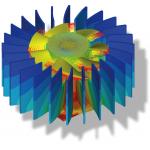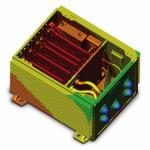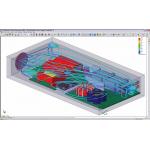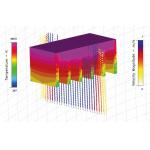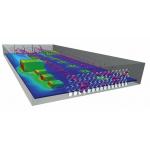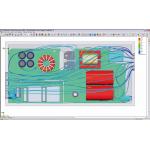May 1, 2006
By Louise Elliott
Everyone involved in the design of electronics—an application area that spans many different industries—agrees on at least one thing: excessive heat is the leading cause of failure in electronics equipment. And the problem is only becoming greater as designers keep creating ever smaller, more tightly packed, and thus hotter products.
“If there’s a rule of thumb in electronics design,” says Ruben Bons, western region technical manager for Blue Ridge Numerics, makers of CFdesign software, “it’s that designers always want more power in less space, which leads to higher temperatures and the problem of how to get rid of it.”
|
|
| CFdesign from Blue Ridge Numerics. |
› › This microchip cooler was designed and modeled with CFdesign. Details of air flow are accurately portrayed for easy design changes.
The most serious heat transfer problems attach to such products as communications tools mounted on trucks, security cameras, and the like, Bons says. This occurs because such devices have to look good and also function in a wide range of environments. Fans, the most commonly used cooling devices, often can’t be used in such applications.
“If you have a security camera in the field in a remote location, you want to improve reliability,” says Bons, “not add components that may break down. Other applications don’t want fans because of noise and because the fan motor is yet another source of heat. Suppose the device is on the roof of a vehicle in the desert. The designer has to account for solar heating, reflected heat from the vehicle, and so on.”
|
|
| CFdesign from Blue Ridge Numerics. |
‹ ‹ All cooling in this ruggedized electronics device occurs via heat pipes and sinks (no vents or fans). CFdesign simulations had to include coupled effects of conduction, radiation, and natural convection in an operating environment where temperatures vary widely. Click to enolarge.
If such considerations preclude the use of fans, “heat sink fins, thermoelectric coolers, and heat pipes can help to take heat away,” says Arvind Krishnan, product manager for SolidWorks Corp.’s COSMOSFloWorks. “CFD can help the designer discover which of these solutions gives the best cooling, and make it possible for him to run multiple what-if scenarios to find the best design.”
“Without CFD, engineers can guess which solutions are best, based on the heat generated by the various components,” says Richard Thoms, CFD product manager for ESI Group. “Obviously this isn’t as useful as knowing the full thermal information—and CFD helps designers change their designs and design parameters to get the best thermal performance.”
Packaging (component placement within the product) for electronic devices becomes very important as the products get smaller, Krishnan points out. “The same chip components may be packaged differently depending on the product, say a laptop computer or a cell phone. The electronics designer chooses the components, but the integrated circuit designer places them. They need CFD to spot what isn’t obvious about heat generation.”
Which Engineering Team Uses CFD?
A conflict may exist about which engineering department—electronic or mechanical—should run CFD analyses. While all the vendors believe that both groups would benefit from upfront use of CFD, the users with whom we spoke are all mechanical engineers.
“Electronic product design often involves different groups of engineers,” says Bons. “If the electrical engineers work first, they may give a finished design to mechanical engineers who design the packaging. But if they work together, the mechanical engineer may be able to suggest the coolest placement of electronic components and save a lot of time.”
|
|
| COSMOSFloWorks from SolidWorks |
› › COSMOSFloWorks was used here to study the air flow distribution using flow trajectories inside a switchable power supply for an electronic circuit board application. Click image to enlarge.
Krishnan notes that the individual company culture governs whether integrated circuit designers are likely to learn to run upfront CFD, even though they don’t usually use MCAD. “Electronic designers are aware of CFD, and they need to know that it can help them weed out badly positioned components that produce too much heat, and thus failures and poor performance,” he says.
Electronics engineers often don’t worry about heat transfer and pass the problem along to mechanical engineers, Thoms says. “We want to bring CFD tools to electronics engineers to do initial runs, and reduce re-design and performance problems.”
In the Electronic Design Trenches
Jim Petroski is package design and analysis engineer for GELcore, a joint venture of General Electric and Emcore, in Valley View, OH. The company makes high-brightness LED systems for lighting in applications that include traffic signals, illuminated signage, and as a replacement for neon in exposed neon-look products. He uses CFD-CADalyzer and CFD-ACE+ from ESI, and reports that CFD has proven to be very important in the design of traffic signals.
|
|
| CFD-CADalyzer from ESI Group |
‹ ‹ CFD-CADalyzer was used in this example to determine the best thickness for heat sink fins used to cool an electronic lighting component.
The sealed units have both heat transfer and air recirculation issues. “With no inlets or outlets, the air heats and rises. Then, when somewhat cooled by contact with the signal light’s case, it falls again, creating a conjugate heat problem,” Petroski says. “It also represents a flow pattern that cannot be modeled with any approach but CFD.”
He adds that he also uses CFD for heat sink design: “We often design unusual shapes of heat sinks, and need to know how to orient them to get the best results. CFD helps us study the natural convection of different orientations.”
Sechan Electronics, Inc., Lititz, PA, manufactures ruggedized military electronics that often don’t allow for fans or vents. Jim Smith, lead mechanical engineer for the company, says that Sechan’s products have to perform reliably in very demanding environments, “mounted next to guns, or placed under water. If a soldier sets out to turn the knob on a system that’s been in service for three years, it had better work.”
He uses CFdesign to help Sechan’s engineers understand how the product will work in real service environments. “Our goal is to iron out the design very early on,” Smith says, “and create a product that we understand, so that when we build it physically, it works the first time. We succeed at that quite often.”
Although it takes time and energy to develop good models, he reports that “CFD gets us though qualification tests faster. In setting up physical tests, it’s possible to miss things, because you can only use so many instruments, but simulation lets us look at any and every part.”
|
|
| CFD-CADalyzer from ESI Group |
› › In this example, CFD-CADalyzer modeled heat flow within an enclosure to determine the best placement of heat-generating components. Clcik to enlarge.
Sechan uses CFD at several stages of the design. “We do a fast analysis to make sure the model has been set up correctly and the results will be accurate,” he says. “We use simplified geometry for initial simulation runs when dealing with very complex designs, or we may go straight into simulation with straightforward designs. We’re always looking at transient situations, and want to be able to answer what will happen if fans—should they be installed—cut out. Do we have time to fix them, or will the equipment fry right away? This helps users plan what spares will be needed, and be prepared for any other maintenance issues.”
Aethercomm of San Marcos, CA, makes high-power linear and pulsed radio frequency, microwave, and millimeter wave amplifiers for military, satellite, and wireless communications—mostly for data transmission.
Todd Crutchfield, a mechanical engineer for the company, says that many of the products are meant for military applications, and so have to meet MIL specs for shock, vibration, and other severe service requirements. A frequent user of COSMOSFloWorks, he says that CFD helps to simulate real-life situations, “and lets the engineer see a lot more than he can any other way. The real purpose of simulation is to find any effects we had not intended, and to correct them before building and breaking prototypes.”
|
|
| COSMOSFloWorks from SolidWorks |
‹ ‹ This COSMOSFloWorks study of a circuit board design describes temperature distribution in the components, and allowed the designer to choose how to best locate suitable cooling fans and proper vent locations.
In Aethercomm’s application, Crutchfield says, engineers need to study power dissipation applied to a heat sink or metal plate, and this is difficult to determine with physical tests, especially regarding temperature gradients through solid materials. “Ideally, as we design higher power devices and encounter more heat in physically smaller packages,” he says, “simulation shows us where the heat goes, and how to dissipate it. This helps us to meet specifications and minimize design time.”
Smith of Sechan reports that CFD has saved the company development time, reduced prototypes, and led to improved products—the goal of both vendors and users. “If we can reduce the temperature by even five degrees,” he says, “we have a more reliable product and better performance.”
Contributing Editor Louise Elliott is a freelance writer based in California. Offer Louise your feedback on this article through e-mail by clicking here. Please reference “Keeping Cool, June 2006” in your message.
Company Information
Aethercomm
San Marcos, CA
CFdesign
Blue Ridge Numerics
Charlottesville, VA
CFD-CADalyzer
ESI Group
Paris, France
GELcore
Valley View, OH
Sechan Electronics, Inc.
Lititz, PA
COSMOSFloWorks
SolidWorks Corp.
Concord, MA
Subscribe to our FREE magazine, FREE email newsletters or both!
About the Author
DE’s editors contribute news and new product announcements to Digital Engineering.
Press releases may be sent to them via [email protected].







